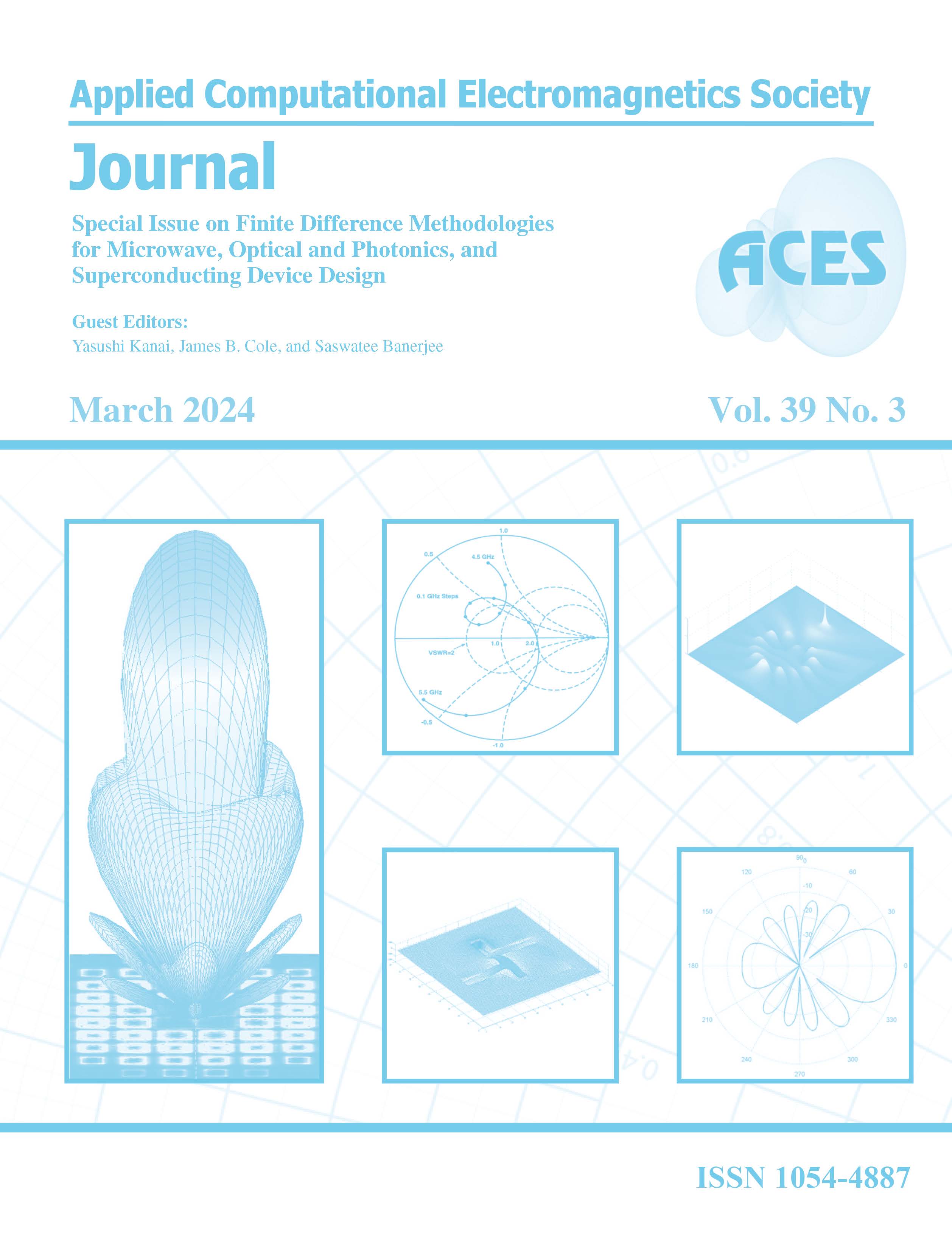Wideband Low-Profile Fabry-Perot Cavity Antenna with Metasurface
DOI:
https://doi.org/10.13052/2024.ACES.J.390312Keywords:
Fabry-Perot cavity, high gain, low-profile, widebandAbstract
A novel Fabry-Perot cavity (FPC) antenna with metasurface is presented, which can achieve broad bandwidth and low profile. Traditional FPC antennas, with rectangular microstrip antennas as feeds, have limited impedance bandwidth and struggle to make a compromise in the gain bandwidth and maximum gain value. To obtain wide bandwidth, the FPC antenna proposed in this paper utilizes a feed antenna loaded with parasitic patches. To widen impedance bandwidth and gain bandwidth and reduce the profile, a positive phase gradient partially reflective surface (PRS) and an artificial magnetic conductor (AMC) are located above and below the feed antenna, respectively. The phase property of the PRS and AMC also brings in a more smooth gain value curve. To further increase gain values, four metal reflector plates are located around the proposed antenna. The overall dimension of the antenna is 2.5λ0×2.5λ0×0.25λ0 (λ0 is the free space wavelength at 7.5 GHz). Simulated results show that the resonant cavity antenna proposed in this letter exhibits an impedance bandwidth of 13.3% (7–8 GHz) and a 3 dB gain bandwidth of 14.3% (7.02–8.10 GHz). The maximum gain in the whole operating band is 14.5 dBi. The measured results are in good agreement with the simulated ones.
Downloads
References
M. M. Bilgic, and K. Yegin, “High gain, wideband aperture coupled microstrip antenna design based on gain-bandwidth product analysis,” Applied Computational Electromagnetics Society (ACES) Journal, vol. 29, no. 8, pp. 639–646, Sep. 2021.
J. Wang, Y. Li, Z. H. Jiang, T. Shi, M. C. Tang, Z. Zhou, Z. N. Chen, and C. W. Qiu, “Metantenna: When metasurface meets antenna again,” IEEE Transactions on Antennas and Propagation, vol. 68, no. 3, pp. 1332–1347, Mar. 2020.
R. Gardelli, M. Albani, and F. Capolino, “Array thinning by using antennas in a Fabry-Perot cavity for gain enhancement,” IEEE Transactions on Antennas and Propagation, vol. 54, no. 7, pp. 1979–1990, July 2006.
F. Deng and K. M. Luk, “A wideband spherical Fabry-Perot cavity antenna based on positive phase gradient metasurface,” IEEE Transactions on Antennas and Propagation, vol. 71, no. 7, pp. 5558–5565, July 2023.
S. Fang, L. Zhang, Y. Guan, Z. Weng, and X. Wen, “A wideband Fabry-Perot cavity antenna with single-layer partially reflective surface,” IEEE Antennas and Wireless Propagation Letters, vol. 22, no. 2, pp. 412–416, Feb. 2023.
R. Orr, G. Goussetis, and V. Fusco, “Design method for circularly polarized Fabry-Perot cavity antennas,” IEEE Transactions on Antennas and Propagation, vol. 62, no. 1, pp. 19–26, Jan.2014.
Z.-G. Liu, Z.-X. Cao, and L.-N. Wu, “Compact low-profile circularly polarized Fabry-Perot resonator antenna fed by linearly polarized microstrip patch,” IEEE Antennas and Wireless Propagation Letters, vol. 15, pp. 524–527, 2016.
M. Y. Jamal, M. Li, K. L. Yeung, X. Li, L. Jiang, and T. Itoh, “A low-profile Fabry-Pérot cavity antenna using anisotropic metasurface,” IEEE Antennas and Wireless Propagation Letters, vol. 21, no. 2, pp. 356–360, Feb. 2022.
Z.-G. Liu, C. Zhang, R.-J. Yin, and W.-B. Lu, “Multifunctional low-profile Fabry-Perot resonator antenna integrated with solar cells,” IEEE Transactions on Antennas and Propagation, vol. 70, no. 8, pp. 7175–7180, Aug. 2022.
J. Chen, Y. Zhao, Y. Ge, and L. Xing, “Dual-band high-gain Fabry-Perot cavity antenna with a shared-aperture FSS layer,” IET Microwaves, Antennas & Propagation, vol. 12, no. 13, pp. 2007–2011, July 2018.
X. Zhao, Y. Liu, J. Zhang, and W. Zhang, “Design of a low-profile Fabry-Perot resonant cavity antenna using fractal EBG ground plane,” in 2021 International Conference on Microwave and Millimeter Wave Technology (ICMMT), pp. 1–3, Nanjing, China, 2021.
G. V. Trentini, “Partially reflecting sheet arrays,” IRE Transactions on Antennas and Propagation, vol. AP-4, no. 4, pp. 666–671, Oct.1956.
N. Wang, C. Zhang, Q. Zeng, N. Wang, and J. Xu, “New dielectric 1-D EBG structure for the design of wideband resonator antennas,” Progress in Electromagnetics Research Letters, vol. 141, pp. 233–248, 2013.
Y. Wang and A. Zhang, “Dual circularly polarized Fabry-Perot resonator antenna employing a polarization conversion metasurface,” IEEE Access, vol. 9, pp. 44881–44887, 2021.
S. Fang, L. Zhang, Y. Guan, Z. Weng, and X. Wen, “A wideband Fabry-Perot cavity antenna with single-layer partially reflective surface,” IEEE Antennas and Wireless Propagation Letters, vol. 22, no. 2, pp. 412–416, Feb. 2023.




